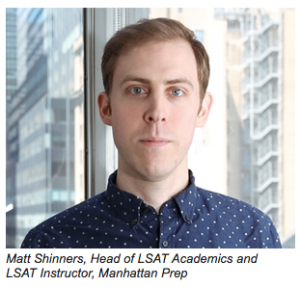Even if you know nothing about the LSAT, you should sit down and take that first diagnostic.
 It all starts with an LSAT practice test.
It all starts with an LSAT practice test.
That’s the recommendation I give all of my students. Even if you know nothing about the LSAT, you should sit down and take that first diagnostic.
There are two primary reasons you want to take your initial LSAT PrepTest blind:
- Your score will be a bit deflated simply because of your unfamiliarity with the format of the test. The LSAT can be extremely discouraging, so the easy wins earned by building familiarity can keep you motivated during the early stages of studying.
- A blind diagnostic is the best (though still an imperfect) indicator of how long it’ll take you to get to your target score.
So go take a diagnostic, see how you do (for this, I recommend using LSAT Navigator, our online PrepTest scorer, review assistant, and recommendation engine), and come back.
Have your score? Great! Don’t worry about what it is; it’s just a baseline. It won’t determine where you’ll end up, just how much work it’ll take to get to your goal score
So based on your score, how long will it take you to get to your goal score?
It depends on on how many points away you are from your target score:
- 5 or fewer: You’re in much better shape than the average person and, depending on what your goal score is, you should be set in a month or two, if not sooner.
- 8-12: This is the average score improvement most people will see in 3-4 months of prep.
- 15+: You’re in it for the long haul. Expect at least 4 months, but probably closer to 6.
- 20+: That’s quite a jump, and you should generally expect it to take at least 6 months to see that amount of improvement.
These numbers are super rough and depend on a number of factors, so let’s look at everything that could increase or decrease the amount of time it’ll take you to get to a certain level of improvement:
The Closeness-to-Perfection Paradox
While going up 10 points is always going to be a battle, raising your score from a 145 to a 155 is generally going to be less difficult than raising your score from a 165 to a 175. At Manhattan Prep, we call this the the Closeness-to-Perfection Paradox: The closer you are to a perfect score, the harder each additional point is to earn (since those questions tend to be harder).
Because of this, if you’re starting from a lower score, you can expect to hit your target score faster than someone starting from a higher score (on average and assuming that you’re both looking to improve by the same amount). Conversely, the closer you are to the top of the score band, the more effort you will generally need to expend to see gains.
The Issue of Timing
The number of questions you need to skip because of timing has an impact on how long it’ll take to prep. Since those questions are ones you could have potentially answered correctly given enough time, fixing timing can have a huge impact on your score.
Students typically have varying degrees of ease “fixing” their timing issues; some adapt quickly, while others struggle.
That said, the average person doesn’t complete all questions on the diagnostic. The issue of timing mostly applies to people who are skipping a good 40% of the section up front, not those who are 5 or fewer questions away from completion.
Section Strength
Some sections are easier to improve on than others. For most people, the ranking is Logic Games > Logical Reasoning > Reading Comprehension, though there’s a lot of variability here.
If your primary section for improvement is Logic Games, you’ll probably have a shorter path to seeing your desired improvement. If it’s Reading Comp, expect it to take a little bit longer to see those score gains. If it’s Logical Reasoning, you’re probably close to the average.
Scheduling Your Test
The LSAT is only offered on certain dates (February, June, September/October, and December). This means that you’ll need to plan out exactly when you want to take the exam, which will be based on your life and the amount of prep time you need. (Pro tip: I recommend the June LSAT, if possible; it allows for a September retake while still allowing you to apply early. It’s also in the afternoon, which can be beneficial for all those non-morning people.)
Next Steps
If you’re planning on applying to law school this coming admissions cycle and want to take the June test, the time to start your prep is probably now. Take your first practice test and use LSAT Navigator to analyze it. For prep materials, I recommend Manhattan Prep LSAT Strategy Guides, and if you need expert teaching to get yourself to the next level, remember that you can try the first session of any of our online or in-person LSAT Complete Courses for free.
And don’t forget to Follow Manhattan Prep LSAT on Facebook to receive updates about live broadcasts from me, featuring tips and tricks to master the test.
Matt Shinners is an LSAT Instructor and Head of LSAT Academics for Manhattan Prep. A graduate of Harvard Law School, Matt owns a perfect 180 LSAT score and has made a career combining his passion for teaching with knowledge of the test to help students achieve their goals. Manhattan Prep is a leader in LSAT prep, with courses engineered using the latest techniques in learning science to optimize high-level learning. Sound interesting? You can try the class for free.


댓글